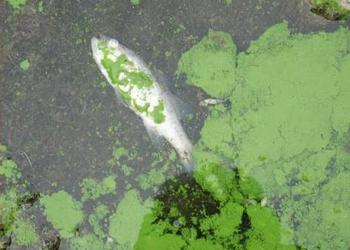
RESTON, Virginia, February 21, 2016 (ENS) – Scientists with the U.S. Geological Survey have found toxins produced by algae, known as microcystins, in 39 percent of the small streams assessed in the southeastern United States.
Their study looked at 75 streams in parts of Alabama, Georgia, North Carolina, South Carolina and Virginia.

“This is the first systematic stream survey of algal toxins in the southeastern United States,” said Keith Loftin, the USGS research chemist who led the study.
“It’s important, because it provides a better understanding of the occurrence of these microcystins in aquatic ecosystems with flowing waters,” he said.
Public health practitioners and medical researchers have observed a range of symptoms in humans after exposure to microcystins. Symptoms can include nausea, dermatitis and, in severe cases, liver failure.
Toxicity issues have been reported for humans, companion animals, livestock and wildlife.
Previous research has indicated that cyanobacteria, a form of blue-green algae capable of producing microcystins, were found in 74 percent of the streams assessed throughout the southeastern United States. However, that research did not include the study of the microcystins themselves.
Microcystins are among the most commonly reported and widely studied cyanotoxins, and Loftin says concerns are growing due to apparent increases in the frequency and severity of human and ecological health effects.
The maximum microcystin concentration measured in this study, 3.2 micrograms per liter (µg/L), did not exceed World Health Organization moderate risk thresholds, 10 µg/L, in the streams sampled.
Still, the scientists advise that further research is needed to understand the potential effects of the microcystins on water quality and related environmental health concerns in downstream aquatic ecosystems, lakes and drinking water reservoirs.
The environmental health significance and causal factors controlling the distribution and magnitude of microcystin occurrence remains poorly understood, the USGS says.

To increase scientific understanding of microcystins, this study is the first of several regional assessments of algal toxins, including the Pacific Northwest, the Northeast and California, being planned and conducted now.
Together, these studies will provide baseline data across the United States to understand and document the extent, magnitude, and sources of algal toxins in the environment.
Baseline data from these regional studies are being used to inform new research that will be focused on investigations of land use and other factors that may affect or create new environmental pathways of exposure to cyanobacteria and microcystins.
“Ongoing work by the USGS in the Pacific Northwest and planned work in the northeastern United States and California will expand our understanding of cyanobacteria and toxins in a wider variety of aquatic ecosystems,” the agency said in a statement announcing the findings on microcystins.
Support for this work was provided by the USGS’ Toxic Substances Hydrology Program and the National Water Quality Assessment Program.
Copyright Environment News Service (ENS) 2016. All rights reserved.
